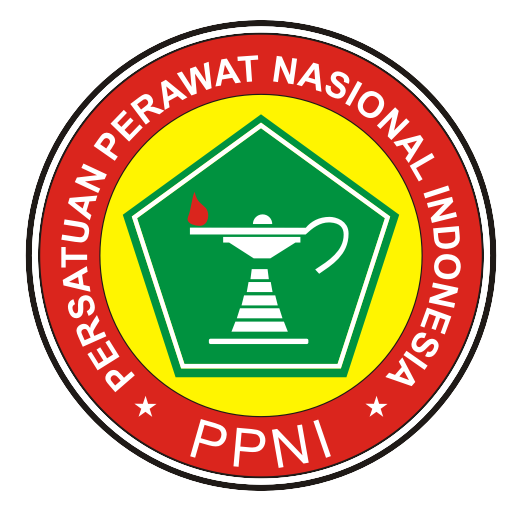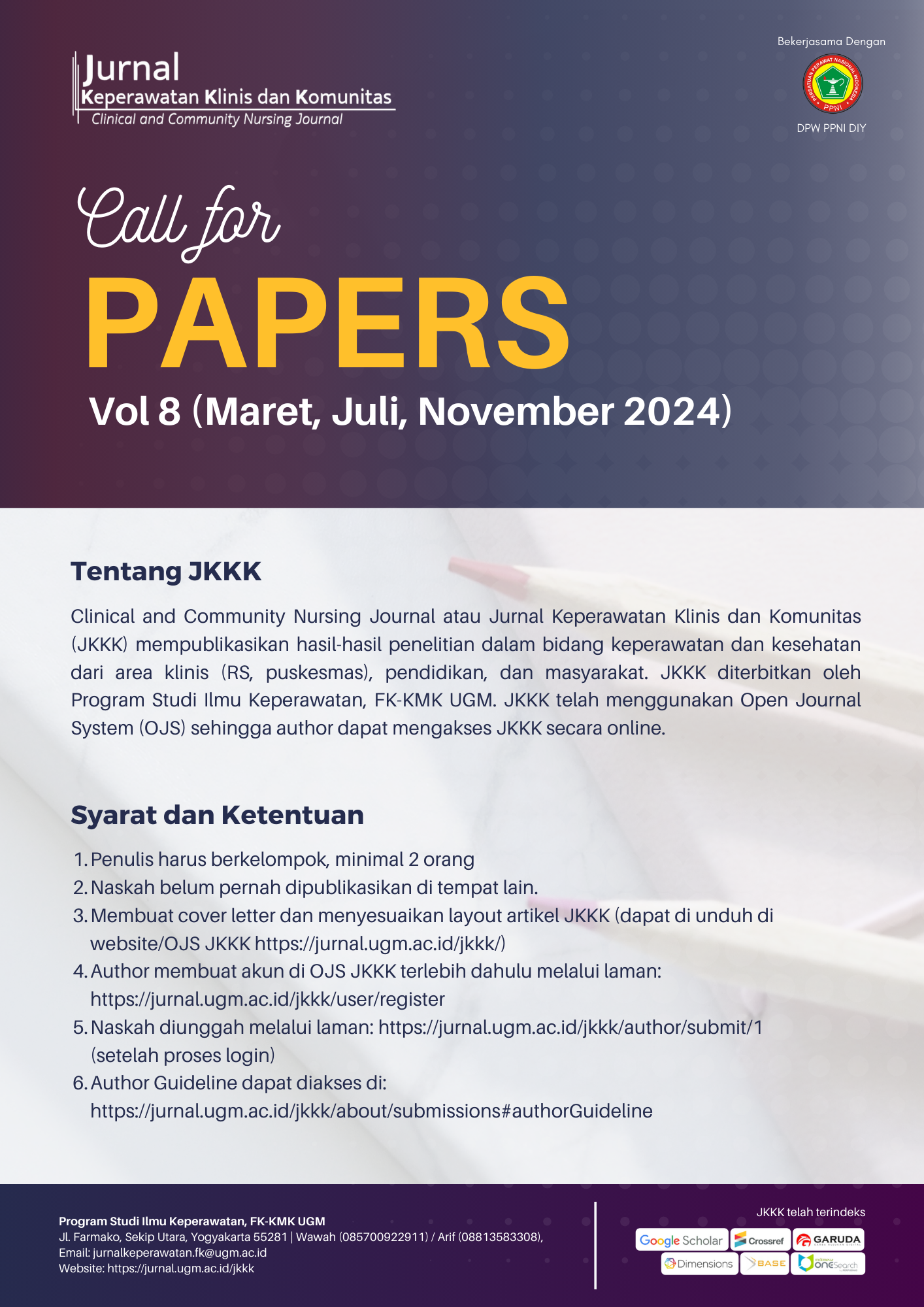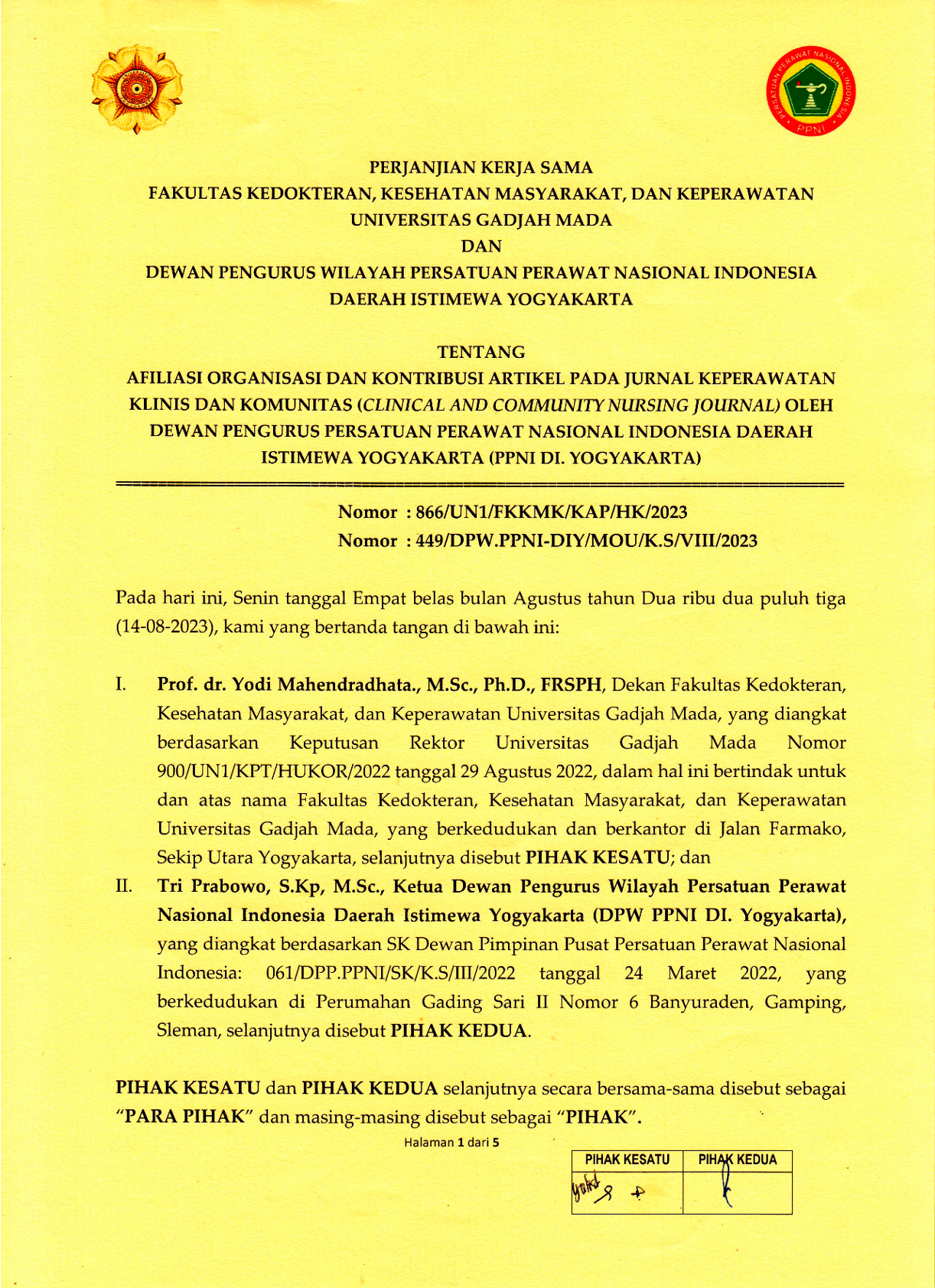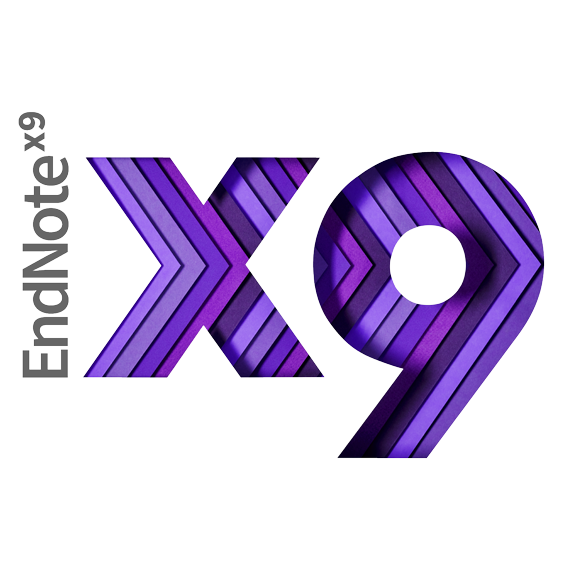Perbedaan Efektivitas Terapi Menelan Berdasarkan Karakteristik Demografi Pasien Disfagia Stroke
Bayu Fandhi Achmad(1*), Aan Nuraeni(2), Muhammad Zafrullah Arifin(3)
(1) Departemen Keperawatan Dasar dan Emergensi, Fakultas Kedokteran, Kesehatan Masyarakat, dan Keperawatan, Universitas Gadjah Mada
(2) Program Studi Magister Keperawatan, Fakultas Keperawatan, Universitas Padjadjaran
(3) Program Studi Ilmu Bedah Saraf, Fakultas Kedokteran, Universitas Padjadjaran
(*) Corresponding Author
Abstract
Background: Increased risk of aspiration often occurs in patients with dysphagia stroke due to cranial nerve damage. The existing method for lowering aspiration risk has weaknesses so that a new therapy is needed that is swallowing therapy.
Objective: This study aims to determine the effect of swallowing therapy and to identify differences in the effectiveness of swallowing therapy based on the demographical characteristics of patients with dysphagia stroke.
Methods: The design of this study was quasi-experimental pretest-posttest single group design with the number of samples were 16 respondents which obtained through consecutive sampling technique. The data were collected from February-March 2016 at Stroke Unit of RSUD Dr. Harjono Ponorogo through observation using Gugging Swallowing Screen (GUSS) instrument. The data analyses used in this study were Wilcoxon test, Kruskal Wallis and Mann Whitney tests.
Results: The results showed that there was a difference of effect of swallow therapy between pretest and posttest (p=0,002). Swallowing therapy had no significant effectiveness difference when applied to various demographic characteristics of respondents including age (p=0,596), gender (p=0,243), and type of stroke (p=0,524).
Conclusion: Swallowing therapy has a positive effect to decrease the risk of aspiration in dysphagia stroke patients and has equally good effect if applied to a variety of patient characteristics according to the demographics of the study respondents.
ABSTRAK
Latar Belakang: Peningkatan risiko aspirasi pada pasien disfagia stroke disebabkan karena kerusakan saraf kranial terutama saraf kranial V, VII, IX, X, dan XII. Metode yang digunakan untuk menurunkan risiko aspirasi adalah strategi kompensasi dan penggunaan nutrisi semisolid, akan tetapi masing-masing metode tersebut masih memiliki kelemahan sehingga dibutuhkan terapi baru yaitu terapi menelan yang mengkombinasikan kelebihan dan mengurangi kelemahan dari masing-masing terapi tersebut.
Tujuan: Penelitian ini bertujuan untuk mengetahui pengaruh terapi menelan dan mengidentifikasi perbedaan efektivitas terapi menelan berdasarkan karakteristik demografi pasien disfagia stroke.
Metode: Desain penelitian ini adalah quasi experimental pretest-posttest single group design dengan jumlah sampel sebanyak 16 responden yang didapatkan melalui teknik consecutive sampling. Pengambilan data dilakukan dari Bulan Februari - Maret 2016 di Unit Stroke RSUD Dr. Harjono Ponorogo. Data dikumpulkan menggunakan instrumen Gugging Swallowing Screen (GUSS). Analisis data menggunakan Wilcoxon, Kruskal wallis dan Mann whitney.
Hasil: Hasil penelitian menunjukkan terdapat perbedaan pengaruh terapi menelan antara pretest dan posttest (p=0,002). Tidak terdapat perbedaan efektifitas terapi menelan yang signifikan saat diterapkan pada berbagai karakteristik demografi responden yang meliputi usia (p=0,596), jenis kelamin (p=0,243), dan jenis stroke (p=0,524).
Kesimpulan: Terapi menelan berpengaruh terhadap penurunan risiko aspirasi pada pasien stroke dengan disfagia serta tidak memiliki perbedaan efektifitas yang signifikan saat diterapkan pada berbagai karakteristik demografi responden, untuk itu terapi menelan memiliki efektifitas yang sama baiknya jika diterapkan pada berbagai karakteristik pasien.
Keywords
Full Text:
PDFReferences
American Heart Association. Guideline for the prevention of stroke in patient with stroke and transient ischemic attack. 2014:1-73.
Daulay NM, Setiawan S, Febriani N. Pengalaman keluarga sebagai caregiver dalam merawat pasien strok di rumah. JKP. 2014;2(3):161–170.
Kementerian Kesehatan Republik Indonesia. Riset kesehatan dasar. Badan Penelitian dan Pengembangan Kesehatan Kementrian Kesehatan Republik Indonesia. 2014. Jakarta.
A’la MZ, Yosep I, Agustina HR. Pengaruh bereavement life review terhadap kesejahteraan spiritual pada keluarga pasien stroke. JKP. 2017;5(2):214–226.
Obara H, Yasuka T, Mamoru D. Improvement in the nutritional status of every elderly stroke patients who received long-term completetube feeding. E Spen Eur E J Clin Nutr Metab. 2010;5(6):e272-6.
Andersen UT, Beck AM, Kjaersgaard A, Hansen T, Poulsen, I. Systematic review and evidence based recommendations on texture modified foods and thickened fluids for adults (≥18 years) with oropharyngeal dysphagia. E-SPEN Journal. 2013;8:e127–e134.
Langdon PC, Lee AH, Binns CW. Dysphagia in acute ischaemic stroke: severity, recovery and relationship to stroke subtype. J Clin Neurosci. 2007;14(7):630–4.
Gandolfi M, Smania N, Bisoffi G, Squaquara T, Zuccher P, Mazzucco S. Improving Post-Stroke Dysphagia Outcomes Through a Standardized and Multidisciplinary Protocol : An Exploratory Cohort Study. 2014;704–12.
Jeyaseelan RD, Vargo MM, Chae J. National Institutes of Health Stroke Scale ( NIHSS ) as An Early Predictor of Poststroke Dysphagia. PM&R. 2015;1–6. Available from: http://dx.doi.org/10.1016/j.pmrj.2014.12.007
Kojima A, Imoto Y, Osawa Y, Fujieda S. Predictor of rehabilitation outcome for dysphagia. Auris Nasus Larynx. Auris Nasus Larynx. 2014;41(3):294–8. Available from: http://dx.doi.org/10.1016/j.anl.2013.12.009
Albert SJ, Kesselring J. Neurorehabilitation of stroke. J Neurol. 2012;259:817–832.
Johnson DN, Herring HJ, Daniels SK. Dysphagia Management in Stroke Rehabilitation. Curr Phys Med Rehabil Rep. 2014;207–18.
Fernandez MG, Ottenstein L, Atanelov L, Christian AB. Dysphagia after stroke: an overview. Curr Phys Med Rehabil Rep. 2013;1:187–196.
Momosaki R, Abo M, Kakuda W. Applicability of the Two-Step Thickened Water Test in Patients With Poststroke Dysphagia : A Novel Assessment Tool for Paste Food Aspiration. J Stroke Cerebrovasc Dis. 2013;22(6):817–21. Available from: http://dx.doi.org/10.1016/j.jstrokecerebrovasdis.2012.05.011
Funami T, Ishihara S, Nakauma M, Kohyama K, Nishinari K. Food Hydrocolloids Texture design for products using food hydrocolloids. Food Hydrocoll. 2012;26(2):412–20. Available from: http://dx.doi.org/10.1016/j.foodhyd.2011.02.014
Falsetti P, Acciai C, Palilla R, Bosi M, Carpinteri F, Zingarelli A, et al. Oropharyngeal Dysphagia after Stroke : Incidence , Diagnosis , and Clinical Predictors in Patients Admitted to a Neurorehabilitation Unit. J Stroke Cerebrovasc Dis. 2009;18(5):329–35. Available from: http://dx.doi.org/10.1016/j.jstrokecerebrovasdis.2009.01.009
Ney DM, Weiss JM, Amy JH, Robbins J. Senescent Swallowing: Impact, Strategies, and Interventions. 2009;395–413.
Wheeler-hegland K, Ashford J, Frymark T, Mccabe D, Musson N, Hammond CS, et al. function. 2009;46(2):185–94.
Kelly BN, Huckabee ML, Jones RD, Frampton CMA. Integrating swallowing and respiration: preliminary result of the effect of body position. J Med Speech Lang Pathol. 2007;15(4):347-355.
Fujiwara S, Ono T, Minagi Y, Fujiu-Kurachi M, Hori K, Maeda Y, et al. Effect of supraglottic and Super-Supraglottic swallows on tongue pressure production against hard palate. Dysphagia. 2014;29(6):655–62.
Tamine K, Ono T, Hori K, Kondoh J, Hamanaka S, Maeda Y. Age-related changes in tongue pressure during swallowing. J Dent Res. 2010;89(10):1097–101.
Askim T, Bernhardt J, Salvesen Ø, Indredavik B. Physical activity early after stroke and its association to functional outcome 3 months later. J Stroke Cerebrovasc Dis. 2014;23(5):e305–12. Available from: http://dx.doi.org/10.1016/j.jstrokecerebrovasdis.2013.12.011
Carnaby G, Hankey GJ, Pizzi J. Behavioural intervention for dysphagia in acute stroke: A randomised controlled trial. Lancet Neurol. 2006;5(1):31–7.
Power ML, Fraser CH, Hobson A, Singh S, Tyrrell P, Nicholson DA, et al. Evaluating oral stimulation as a treatment for dysphagia after stroke. Dysphagia. 2006;21(1):49–55.
Suntrup S, Warnecke T, Kemmling A, Kristina I, Christina T, Oelenberg S, et al. Dysphagia in patients with acute striatocapsular hemorrhage. J Neurol. 2012;93–9.
Heart and Stroke Foundation. Management of Dysphagia in Acute Stroke An Educational Manual for the Dysphagia Screening Professional. 2006. Ontario.
Article Metrics
Refbacks
- There are currently no refbacks.
Copyright (c) 2017 Bayu Fandhi Achmad, Aan Nuraeni, Muhammad Zafrullah Arifin

Jurnal Keperawatan Klinis dan Komunitas (Clinical and Community Nursing Journal)
collaborates with DPW PPNI DIY
![]()
Jurnal Keperawatan Klinis dan Komunitas (Clinical and Community Nursing Journal) is licensed under a Creative Commons Attribution-ShareAlike 4.0 International License.




